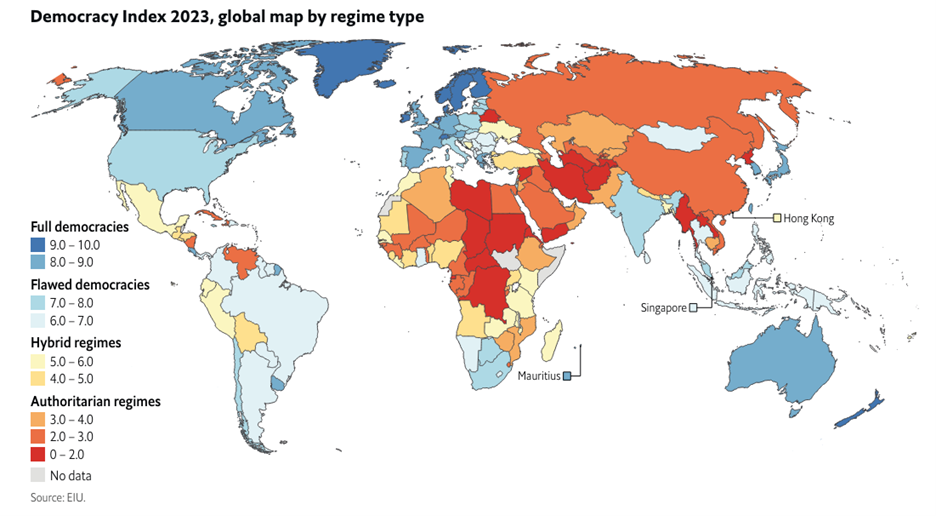 Democracy remains strong in parts of Asia, southern Africa, the Americas, and Western Europe, but has stagnated or declined in other countries. Source: Economist, Economist Intelligence Unit 2024 Democracy Report.
‘Tis the season for the release of annual democracy, human rights, and governance (DRG) indicators. These metrics capture global, regional, and national trends in democracy and governance over time. Policymakers, advocacy groups, and the media rely upon these data sources to frame their positions on key DRG issues. They are important to monitor as they provide information on local needs and dynamics that may affect ongoing USAID programs.
This issue of the Learning Digest summarizes lessons from the latest DRG data and the annual reports of prominent DRG sector public policy organizations and examines the following topics:
- Continued Decline Hits Core Democratic Processes
- Zooming Out: What Explains the Two Decade Decline?
- Mastering Metrics: Causal Attribution Without Randomization
Please make use of DRG Evidence and Learning Team resources! (See text box at the end.)
Continued Decline Hits Core Democratic Processes
2023 was considered another challenging year for democracy. Last year’s stagnation in democratic decline turned out to be a mirage. As the Economist Intelligence Unit said at the time: scores last year stagnated because negative developments globally were canceled out by the positive effect of removing COVID-19 restrictions. Negative trends, unlike the short-term boost from reopening, were part of a long-term trend in democratic decline. In 2023, the trend continued. According to the overall statistics:
Similar to past years, free expression scores saw the largest declines. However, a critical shift emerged in 2023: democracy ratings organizations began noting declines in electoral processes, the very foundation of democracy. Last year the metrics edition of the Learning Digest noted a divergence between democracy-rating organizations, who have sounded the alarm about democracy’s decline, and a separate study that found no decline in competitive electoral results. This discrepancy might be due to two reasons:
- The declining components of democracy were primarily about deliberation and expression, not clean elections, making these declines undetectable through election results.
- Election results could be a lagging indicator, only at risk after other components of democracy had declined.
The stable scores for electoral process changed in 2023 – they no longer seem immune from democratic backsliding. Electoral processes are now worsening according to V-Dem, FH, EIU, and BTI. This raises the question: Will the 2024 Year of Elections (with over 70 national elections) exacerbate these declines in electoral results? Or will democratic electoral institutions remain strong and resilient? With several high-profile elections taking place even before this Learning Digest edition is published, the answer may be unfolding as we speak!
For example, in the 2024 Indian elections, the ruling Bharatiya Janata Party failed to achieve a third consecutive single-party majority, losing seats to various opposition parties across India. This outcome is significant for Indian democracy and, given India's prominent global role, holds broader implications for democracy worldwide.
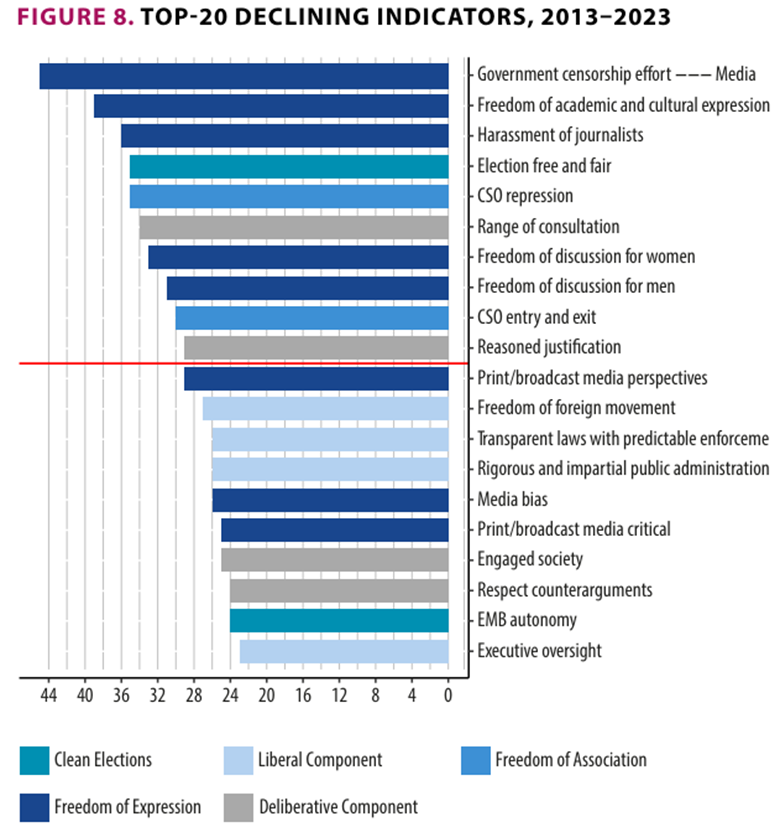 Indicators measuring freedom of expression have declined most over the past 10 years, but in 2023 democracy ratings organizations noted that indicators measuring the quality of electoral institutions were also declining. Source: V-Dem 2024 Annual Report.
Democracy Levels Vary Widely Across Regions, with Worrying Declines
There are significant regional differences in levels of democracy across regions and in recent changes to those democracy levels.
-
The Middle East and North Africa (MENA) Region Remains the Most Autocratic: MENA holds the unfortunate title of the world’s most autocratic region. A staggering 98 percent of its population lives under autocratic regimes, with only Israel (2 percent) classified as a “flawed democracy” in 2023. Israel’s democracy score declined in 2023 due to proposed judicial reforms that sparked protests and strained government institutions; according to V-Dem, it is now categorized as an electoral democracy, the first time it has fallen from the liberal democracy category. (V-Dem p.14; EIU p.3, p.59, and p.61).
-
Democracy Under Threat in Sub-Saharan Africa: Democracy in Sub-Saharan Africa also continues to decline in 2023 amid military coups and flawed elections, with 82 percent of its population now residing in either electoral or closed autocracies. Even historically strong democracies like Botswana, Ghana, Kenya, and South Africa have encountered setbacks in recent years (V-Dem p.14, FH p. 24).
-
Uncertain Trajectory in Asia: Democracy scores in Asia are complex but were, on average, mostly unchanged in 2023 (EIU p.47). Many countries in Asia have held or will hold elections in 2024, so next year’s Metrics edition of the Learning Digest will have much to report.
-
Bright Spots Amid Latin America and the Caribbean (LAC)'s Democratic Challenges: The LAC region remains one of the most democratic regions in the world, but organizations disagree about changes in 2023. While V-Dem says democracy levels increased, especially in large populous countries like Brazil (V-Dem p.9), the EIU, on the other hand, claims LAC experienced the steepest decline globally in 2023 (EIU p.43). This can partially be explained by different scoring criteria: V-Dem is mainly focused on electoral processes and civil liberties, and the EIU agrees that Latin America has robust scores for those components of democracy. However, the region’s EIU scores are brought down because LAC has the worst score globally for political culture and poor performance in government functionality. Despite these challenges, BTI noted that several LAC countries – Chile, Costa Rica, Uruguay, and Jamaica – have consistently maintained their high level of democracy over the past two decades, and noted positive developments in Honduras and Brazil, where recent elections reversed past trends of political regression.
 Citizens and USAID-supported partner organizations demand their rights in an International Women's Day march. Photo: USAID/Honduras 2023
Zooming Out: What Explains the Two Decade Decline?
What explains the almost two-decade decline in the quality of global democracy? No single explanation exists, however, several key factors have been identified:
The first factor is that democracies have struggled with major crises. V-Dem’s Case for Democracy study found that countries in the early stages of democracy struggle to control corruption. BTI and EIU both note that cronyism, mismanagement, and poor governance has eroded trust in democratic institutions and helps explain many recent backsliding events. Highly visible failures like the 2008 global financial crisis and the EU's migration struggles sparked doubts about democracy's effectiveness. These crises shook global confidence in the political and economic systems of “the West” generally. Additionally, the inability of the United States to control the COVID-19 pandemic further hurt the reputation of democracy. To support democracy abroad, democracies must perform at home.
The perceived failures of democracy led to the second factor: emboldened autocracies. As many countries began to doubt the systems promoted by the West, autocracies promoted their own development model focused on extensive state control over politics and society (despite this having little to do with successful development in autocracies). Though democracies enjoy better governance, faster economic growth, better development outcomes, and fewer catastrophic policy failures than autocracies, autocracies have successfully promoted a narrative of efficiency. They exploit propaganda and manipulate data to create the illusion of competency. For example, autocracies overstate official annual Gross Domestic Product (GDP) growth by up to 35 percent and falsified reports of COVID-19 deaths. In addition to pro-autocracy propaganda, autocracies actively undermine democratic systems. They sow division in Western democracies and support candidates who are dismissive of international democratic solidarity and cooperation. This anti-democracy propaganda has been effective, shaking public confidence in their own democratic systems. Democracies, initially unaware of this "propaganda war," have lost ground.
The third factor is weak democratic institutionalization and the rise of ambitious leaders that exploit them. Stable democracy requires strong institutions – strong parties, independent legislatures, courts, counter-corruption agencies, regulatory bodies, election commissions, civil society, mass media, and more – that monitor and limit the power of elected leaders. Weak institutions create opportunities for anti-democratic leaders to consolidate power. Additionally, critics argue that democracy promotion has focused on the transition to democracy, neglecting the ongoing challenges of democratic governance. This is the rationale for USAID’s new focus on countries with democratic openings through supporting their democratic governments to deliver tangible goods for their citizens.
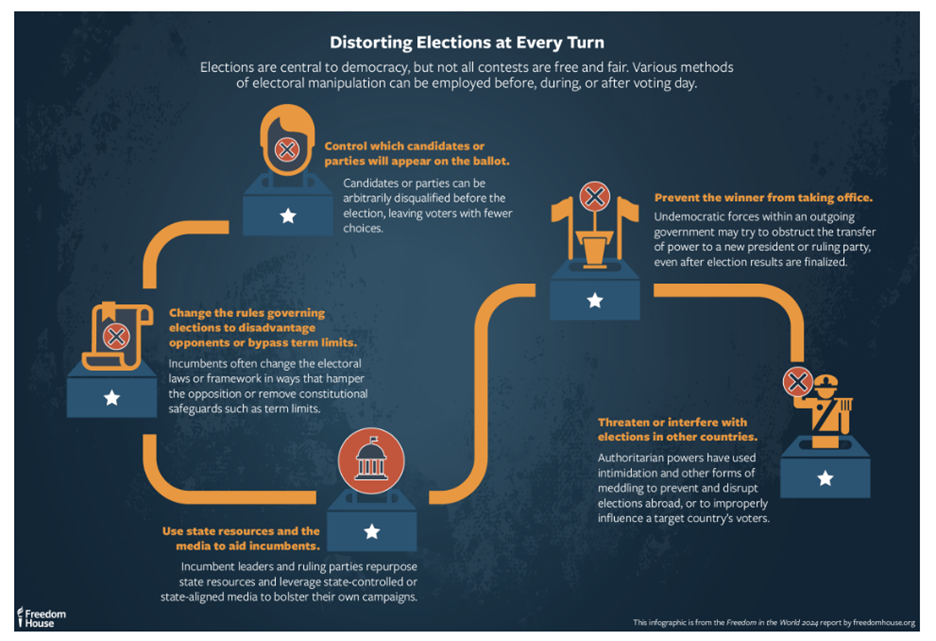 Electoral manipulation threatened to undermine elections. Electoral manipulation can happen in a variety of ways, from controlling who appears on the ballot to aiding certain candidates with state resources. (Freedom House)
Hope Persists Despite Challenges
The democratic declines of the last two decades are concerning, but there’s still reason for optimism. Democracy in the world is still in a far better position than in the 1970s, before the “third wave” of democratization ushered in our current new democratic era. At that time, only 22 percent of nations were democracies; today, that number has more than doubled with roughly 50 percent of countries classified as democracies (V-Dem). Though several countries have backslid into autocracy, this does not indicate an end to democracy. A recent V-Dem study reveals that about half of autocratization episodes since 1900 have transitioned back to democracies, and that number rises to 70 percent when focusing on the last 30 years. The current wave of autocratization should not go on forever.
Mastering Metrics: Measuring Impact Without Randomization
The final section of the Metrics edition always highlights measurement lessons. This year, let’s learn about some innovative methods being used to understand the effects of USAID programs.
The main challenge of evaluating a program is understanding what would have happened if we did not implement the program. Randomized experiments help us understand what would have happened by randomizing who receives the program – the group that did not receive the program tells us what would happen without the program. Randomized experiments are the gold standard for evaluation, but they may not always be feasible. Fortunately, quasi-experimental techniques like difference-in-differences (DiD), synthetic control, and regression discontinuity (RD) can offer a valuable alternative and teach us about the effect of a program even when randomization is not possible. These techniques are increasingly being used at USAID and in the DRG sector to learn about the effects of DRG programs.
Difference-in-Differences (DiD)
One of the major reasons people do not evaluate programs with randomized experiments is that randomization is difficult or impossible. But even when randomization is impossible, it is often possible to identify a group that could have received the program. The DiD method compares outcomes of the treated group with outcomes from a comparison group that did not receive the program. For example, imagine an anti-corruption program that will monitor public procurements of infrastructure projects. A DiD evaluation could compare the monitored procurements to other procurements that are similar to the monitored procurements (e.g., have similar investment costs and budgetary execution capacity). To tell us the effect of the intervention, researchers compare the change in the monitored procurements to the change in the non-monitored comparison procurements. See the figure below for a visual representation.
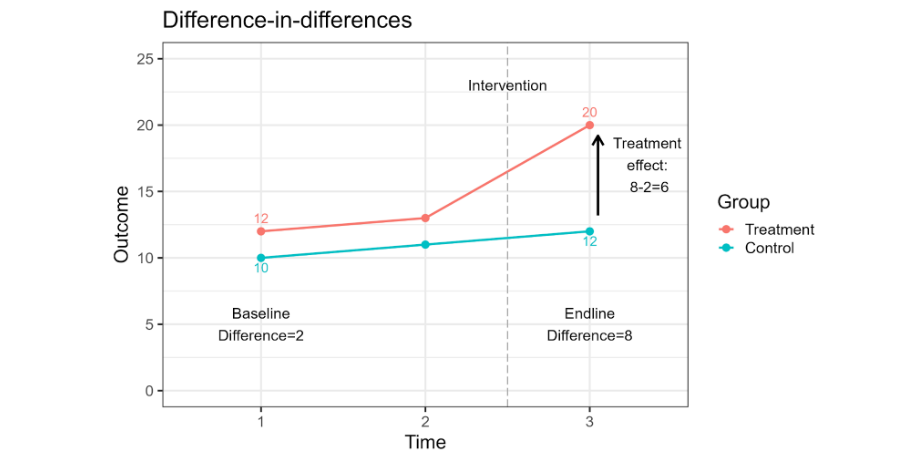 |
A difference-in-differences design compares the change over time between a treatment group and a comparison group. Even if those groups are not randomly selected, if the groups have similar outcome trends then researchers can compare their change over time with a DiD design (Source: Chris Grady).
Synthetic Control
Sometimes finding a suitable comparison group is not possible, and so even a DiD evaluation design isn’t possible. For example, when an intervention works with a country’s Electoral Management Body (EMB), the intervention cannot be randomized and there is no similar group to conduct a DiD analysis. So what can we do to evaluate the intervention’s impact? Synthetic control offers a solution in these situations. To statistically estimate the effect of the intervention, an evaluation would need to create a timeline where everything is identical to the program’s timeline except that no intervention worked with that country’s EMB. Synthetic control does not literally create a new timeline, but it simulates that hypothetical timeline.
Here is how it works:
- First, the method identifies a set of countries with similar characteristics to the treated country (the one working with the EMB).
- Then it statistically combines these countries to create a "synthetic control" unit. This synthetic unit mimics the outcome of the treated country.
- By comparing the actual treated country's post-intervention outcomes with the synthetic control's predicted outcomes, we can estimate the intervention’s impact. Any significant deviations between the two likely stem from the intervention itself.
Synthetic control is useful when you have a single treatment unit that is not directly comparable to any particular control unit. The synthetic control helps us understand what would have happened to the treated country without the intervention by creating a statistically constructed "twin" that undergoes a hypothetical "no intervention" scenario. This allows us to isolate the intervention’s effect, even when traditional comparison groups are not available.
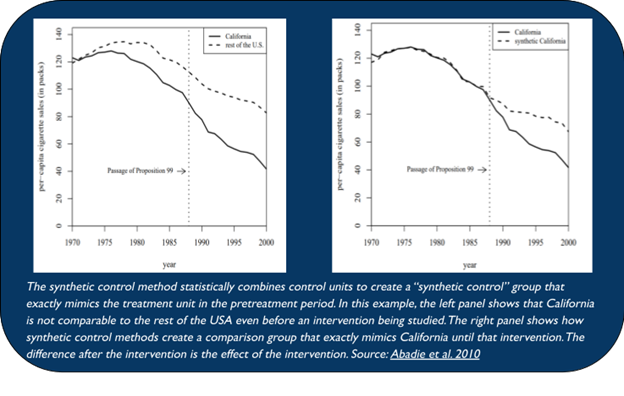 Regression Discontinuity (RD)
Sometimes we administer an intervention to everyone above a threshold, after a certain time, or within a certain geographic area. RD takes advantage of the arbitrary nature of many thresholds. It considers the intervention as if randomized to units just above and just below the threshold. Units just below the threshold function as a control group and units just above function as the treatment group. Similar to a randomized experiment, the effect of the intervention is the difference between the treatment and control group. For example, if an intervention was administered only to people residing within a city’s boundaries, and the city boundary split neighborhoods, RD would compare people within the city to their immediate neighbors outside of the city.
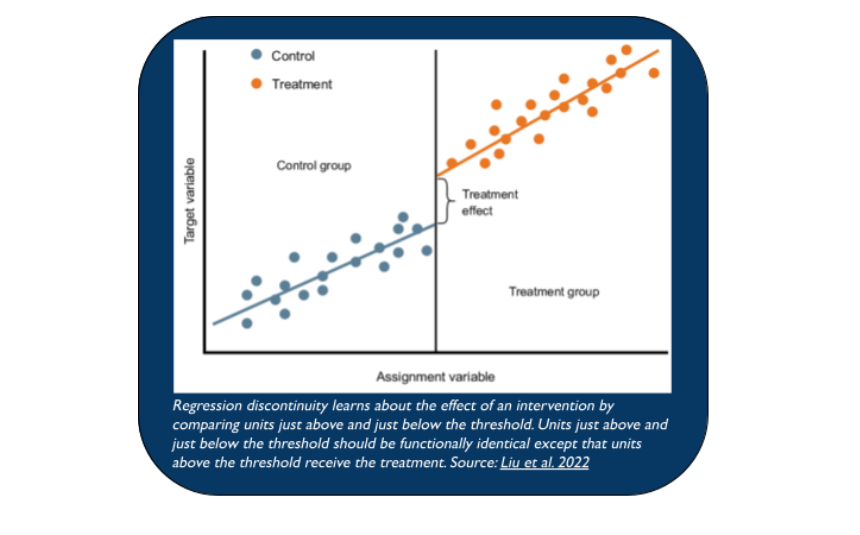 Conclusion
Quasi-experimental methods can help us understand program effects. However, they have limitations. The same way it is not always possible to conduct a randomized experiment, it is not always possible to use these quasi-experimental methods. DiD and synthetic controls are useful when we can identify comparable units, but cannot be used if there are no comparable units. RD is useful when a program is administered to people beyond a threshold, but cannot be used without a strict threshold. It is important to keep in mind that quasi-experiments compare existing groups that might already differ in important ways. To be confident that the results are due to the intervention and not pre-existing differences, researchers must conduct several statistical checks to show that the treatment group and comparison group are comparable. Randomized designs also use statistical checks, but those checks are less complex because randomization ensures that the only difference between the treatment group and control group is that the treatment group receives the intervention. Despite these limitations, quasi-experiments are powerful, but underutilized tools in the evaluation toolbox. Many USAID evaluations could benefit from incorporating these methods, while acknowledging the need for careful analysis for potential limitations.
Further Assistance
If you are interested in learning more about DRG metrics, quasi-experimental evaluation, or how you could incorporate these methods into your programming, please contact Christopher Grady at cgrady@usaid.gov or the DRG Bureau’s Evidence and Learning Team at drg.el@usaid.gov.
Recent and Upcoming DRG Learning Events
DRG Learning Community of Practice
On June 12, the DRG Learning Community of Practice (CoP) discussed leveraging evidence to strengthen government programs with Brigitte Seim and Jake Bowers, fellows at the General Service Administration’s Office of Evaluation Sciences (OES). The OES is a federal interdisciplinary team dedicated to evidence-based policymaking and has collaborated with dozens of agencies across the government, completing over 100 program evaluations. This session delved into their research process, showcasing how it has demonstrably improved federal programs.
DRG Evidence and Learning Talk Series: Do People Do What They Say They Will Do? Comparing Survey and Experiential Measures of Anti-Corruption Voting
On June 26, the DRG Bureau hosted Jake Bowers, Professor of Political Science and Statistics at the University of Illinois, and Matthew S. Winters, Professor of Political Science and the incoming Director of the Center for East Asian and Pacific Studies at the University of Illinois, for a discussion comparing the results of survey experiments and field experiments involving the dissemination of information about political corruption. In doing so, they show that people’s stated reactions in a survey context do not always correspond to their actual behaviors in real-life situations, and raise some concerns about how best to develop an evidence base in domains that rely heavily on survey research.
Tuesday Group: Advancing Women’s Political Empowerment
On Tuesday, June 25, the DRG Bureau invited Saskia Brechenmacher, fellow at the Carnegie Endowment for International Peace, to join a discussion on Advancing Women’s Political Empowerment, a critical foreign policy and assistance objective. She shared key findings from her new book (with Katherine Mann): Aiding Empowerment: Democracy Promotion and Gender Equality in Politics, which critically examines international assistance for women’s political empowerment across Kenya, Myanmar, Morocco, and Nepal and traces the new and recurring challenges facing the field.
Use Our Resources!
Welcome to the DRG Learning Digest, a newsletter to keep you informed of the latest learning, evaluation, and research in the Democracy, Human Rights, and Governance (DRG) sector. Views expressed in the external (non-USAID) publications linked in this Digest do not necessarily represent the views of the United States Agency for International Development or the United States Government.
Check out past editions of the Learning Digest here. Want the latest DRG evidence, technical guidance, events, and more? Check out the DRGLinks website: https://www.drglinks.org/.
Don't forget to check out our DRG Learning Menu of Services! (Link only accessible to USAID personnel.) The Menu provides information on the learning products and services the Evidence and Learning Team offers to help you fulfill your DRG learning needs. We want to help you adopt learning approaches that emphasize best fit and quality.
The Evidence and Learning Team is also excited to share our DRG Learning, Evidence, and Analysis Platform (LEAP) with you. This Platform contains an inventory of programmatic approaches, evidence maps, the DRG Learning Harvest, and inventories of indicators and country data portraits - all of which can be very useful in DRG activity design, implementation, evaluation, and adaptation. Some of these resources are still being built, so check back frequently to see what has been newly added.
The DRG Learning Harvest on LEAP is a searchable database of DRG learning products, including summaries of key findings and recommendations, drop-down menus to easily find documents related to a particular country or program area, and links to the full reports on the DEC.
Each month the DRG Bureau will be sharing with Missions and practitioners a wealth of evidence and learning resources on the themes below. These themes are scheduled a month ahead of international days or months of commemoration in order to get evidence and learning to Missions and practitioners in time to apply it during the month/day being celebrated or honored. In the month following the monthly theme, there will be a Fireside Chat for Missions to engage with the resources shared throughout the month and provide an opportunity for Missions and OUs to share and exchange learning and experiences. If you are interested in contributing to one of the monthly themes or would like to be invited to the Fireside Chats, please reach out to drg.el@usaid.gov.
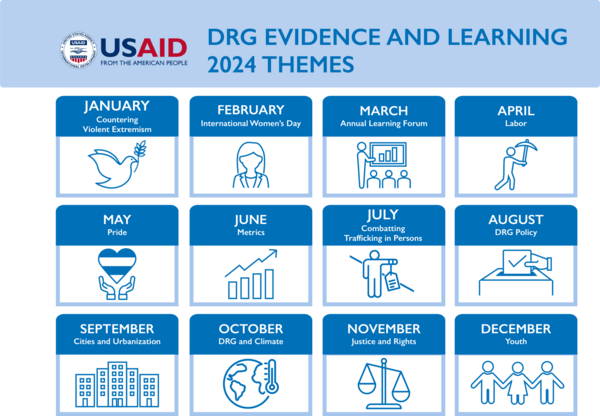
We welcome your feedback on this newsletter and on our efforts to promote the accessibility, dissemination, and utilization of DRG evidence and research. Please visit the DRG Bureau's website for additional information or contact us at DRG.EL@usaid.gov.
|